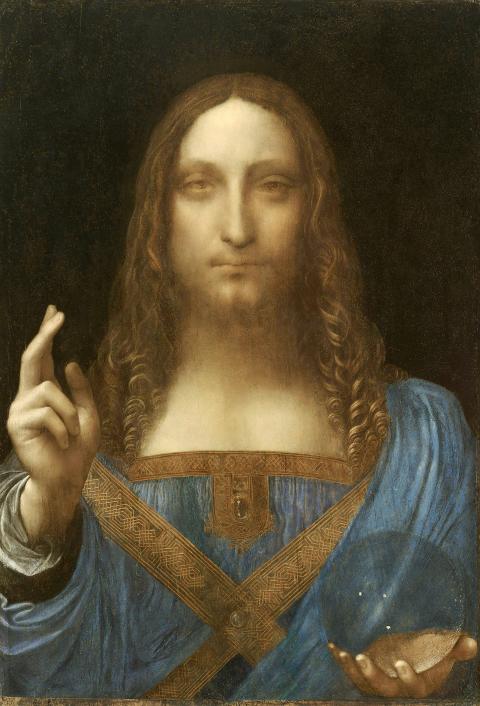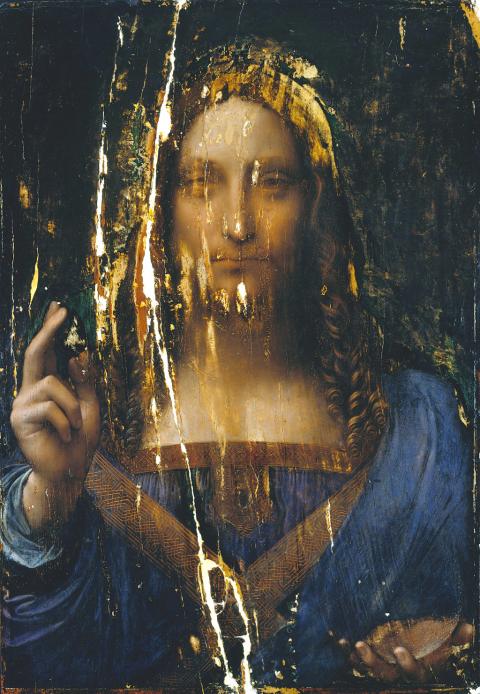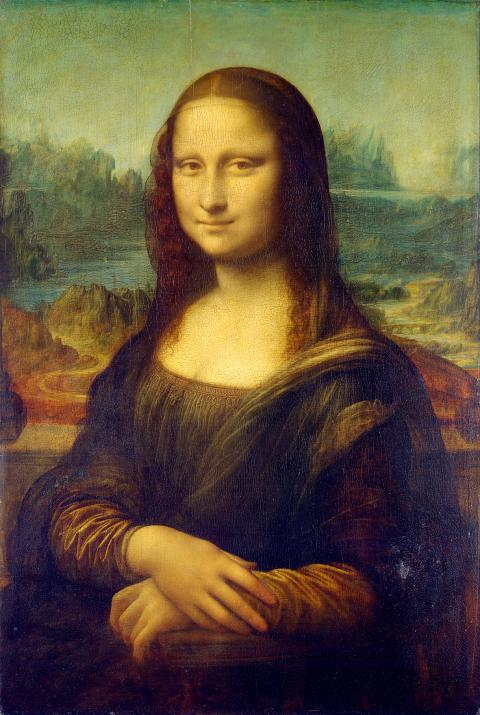On Nov. 15, 2017, the painting Salvator Mundi (Savior of the World, photo 1) was sold for US$450 million (approx. NT$14 billion) at Christies New York, making it the most expensive painting ever sold at auction.
The painting’s buyer is believed to have been a member of the Saudi royal family, and it was originally to be put on display at the Louvre Abu Dhabi in September last year. However, not only were those plans cancelled, this year it was revealed that the painting’s whereabouts are unknown.
What kind of painting can command such a high price? For starters, it has been linked to Leonardo da Vinci, and it is being hailed as the “Male Mona Lisa.”

Photo: Wikimedia Commons
照片:維基共享資源
According to records, Louis XII of France commissioned the Renaissance master Leonardo da Vinci (1452–1519) to paint Salvator Mundi. The theme of Christ giving blessings to the world was a common one at the time. The Christ figure in this work has his right index and middle fingers crossed in a gesture representing the giving of blessings, while the left hand is holding a crystal ball, symbolizing the world.
Da Vinci never signed his works. This, and the fact that he had diverse interests and was endlessly experimenting — and his paintings were often abandoned halfway through, or later destroyed — means that there are now only 19 of his works extant.
Da Vinci’s Salvator Mundi has become something of a Holy Grail in art history, sporadically appearing, only to disappear once more.

Photo: Wikimedia Commons
照片:維基共享資源
There are various theories as to why Salvator Mundi has disappeared this time. One is that experts have concerns over its authenticity. When it was rediscovered in 2005, it was in poor condition (photo 2). One of the reasons for this was that the wooden panel on which it was painted contained a large knot, which had caused the painting to become warped over time. Experts find it difficult to believe that da Vinci, who was so fastidious with technique, would have chosen to use this wood as a surface to paint on.
There are also experts who doubt that da Vinci would have painted a portrait such as the Salvator Mundi square on, in what is quite a formalistic pose. The Mona Lisa (photo 3), by comparison, is posed at a slight angle to the viewer, her left arm leaning against the chair to suggest movement, with the background painted in, using da Vinci’s aerial perspective to express a feeling of space and distance.
The experts who believe the Salvator Mundi is genuine point to the Mona Lisa-esque smile on Christ’s face, a feature common in the majority of da Vinci’s portraits from this period. In addition, Christ’s hair has indications of da Vinci’s trademark brushwork, with the soft vitality and realistic feel it brings.

Photo: Wikimedia Commons
照片:維基共享資源
In this work many factors conspire to ensure that its price is elevated in the art market: the attribution of da Vinci, the archetypal Renaissance artist, the fact that it depicts Christ, and the fact that it has been rediscovered after having been lost for so long. The price is determined by the logic of supply and demand. Regardless of whether or not the painting is an authentic da Vinci, the desire to own one of the artist’s works remains strong today, 500 year’s after da Vinci’s death.
(Translated by Paul Cooper)
紐約佳士得二○一七年十一月十五日的拍賣會上,一幅名為《救世主》(Salvator Mundi)的畫【圖一】,以四點五億美元(約新台幣一百四十億元)的天價成交,成為拍賣史上價格最高的藝術品。
此畫買家據信為沙烏地阿拉伯王室成員,原訂去年九月在阿布達比羅浮宮展出。然而,展出的計畫後來不但取消,今年更爆出此畫已下落不明。
什麼樣的畫會飆到這麼高的售價?「達文西」、「男版蒙娜麗莎」這兩個關鍵詞,就足以解釋了。
據載,法王路易十二曾委託文藝復興巨匠達文西(西元一四五二~一五一九年)作《救世主》一畫。描繪耶穌基督賜福給全世界,是當時流行的主題。此畫中的基督右手食指與中指交叉,象徵祝福,左手則捧著水晶球,象徵世界。
由於達文西從不在作品上簽名,且他興趣廣泛、不斷試驗,他的作品常半途而廢或被毀壞,因此只有十九件畫作流傳下來。
傳說中達文西所繪的《救世主》,便如同藝術史所追尋的聖杯,在歷史洪流中時隱時現。
《救世主》現今神秘消失的原因眾說紛紜,一說是因有專家對其真偽存疑。此畫二○○五年被重新發現時,狀況非常糟【圖二】,原因之一是製作畫板的木材上有個很大的樹節,使畫面因長年受力不均而破裂變形。學者認為極注重技術細節的達文西,不可能會選用此畫板。
另也有專家認為,達文西從不曾把肖像繪成如《救世主》這樣僵硬呆板的正面。相較之下,《蒙娜麗莎》【圖三】不僅以身體微側、左手倚在扶手上製造出動態,背後更繪以風景,以達文西獨創的「大氣透視法」來表現出空間與距離。
認為《救世主》為真跡的專家則指出,基督的面容有如同蒙娜麗莎的微笑──達文西當時的肖像畫多半帶有這樣的微笑。另外,基督的頭髮有達文西特有的筆觸,使之柔軟有彈性、栩栩如生。
文藝復興原型人物達文西、基督、失落而重新尋得……這些神秘的母題都是讓市場價格不斷飆高的元素。價格是由供給與需求所決定,無論真偽,《救世主》的天價反映的是人們巨大的心理需求,在達文西逝世滿五百年後的今日有增無減。
(台北時報林俐凱)

In an effort to fight phone scams, British mobile phone company O2 has introduced Daisy, an AI designed to engage phone con artists in time-wasting conversations. Daisy is portrayed as a kindly British granny, exploiting scammers’ tendency to target the elderly. Her voice, based on a real grandmother’s for authenticity, adds to her credibility in the role. “O2” has distributed several dedicated phone numbers online to direct scammers to Daisy instead of actual customers. When Daisy receives a call, she translates the scammers’ spoken words into text and then responds to them accordingly through a text-to-speech system. Remarkably, Daisy

Bilingual Story is a fictionalized account. 雙語故事部分內容純屬虛構。 Emma had reviewed 41 resumes that morning. While the ATS screened out 288 unqualified, she screened for AI slop. She could spot it a mile away. She muttered AI buzzwords like curses under her breath. “Team player.” “Results-driven.” “Stakeholder alignment.” “Leveraging core competencies.” Each resume reeked of AI modeling: a cemetery of cliches, tombstones of personality. AI wasn’t just changing hiring. It was draining the humanity from it. Then she found it: a plain PDF cover letter. No template. No design flourishes. The first line read: “I once tried to automate my

Every May 1, Hawaii comes alive with Lei Day, a festival celebrating the rich culture and spirit of the islands. Initiated in 1927 by the poet Don Blanding, Lei Day began as a tribute to the Hawaiian custom of making and wearing leis. The idea was quickly adopted and officially recognized as a holiday in 1929, and leis have since become a symbol of local pride and cultural preservation. In Hawaiian culture, leis are more than decorative garlands made from flowers, shells or feathers. For Hawaiians, giving a lei is as natural as saying “aloha.” It shows love and

1. 他走出門,左右看一下,就過了馬路。 ˇ He walked outside, looked left and right, and crossed the road. χ He walked outside and looked left and right, crossed the road. 註︰並列連接詞 and 在這句中連接三個述語。一般的結構是 x, y, and z。x and y and z 是加強語氣的結構,x and y, z 則不可以。 2. 他們知道自己的弱點以及如何趕上其他競爭者。 ˇ They saw where their weak points lay and how they could catch up with the other competitors. χ They saw where their weak points lay and how to catch up with the other competitors. 註:and 一般連接同等成分,結構相等的單詞、片語或子句。誤句中 and 的前面是子句,後面是不定詞片語,不能用 and 連接,必須把不定詞片語改為子句,and 前後的結構才相等。 3. 她坐上計程車,直接到機場。 ˇ She took a cab, which took her straight to the airport. ˇ She took a cab and it took her straight